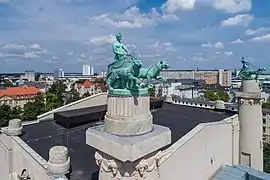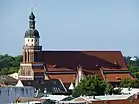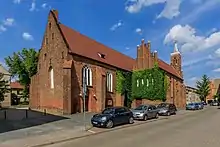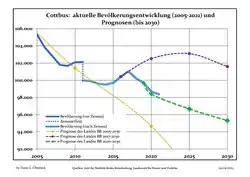Cottbus
Cottbus (German pronunciation: [ˈkɔtbʊs] ⓘ) or Chóśebuz (Lower Sorbian pronunciation: [ˈxɨɕɛbus]) is a university city and the second-largest city in the German state of Brandenburg after the state capital of Potsdam. With around 98,000 inhabitants, it is the most populous city in Lusatia. Cottbus lies in the Sorbian settlement area (Serbski sedleński rum) of Lower Lusatia, and is the second-largest city on the River Spree after Berlin, from which it is situated around 125 km (78 mi) upstream. The city is located on the shores of Cottbus Eastern Lake (Chóśebuski pódzajtšny jazor), which will be Germany's largest artificial lake by surface area when flooding is completed.
Cottbus
Chóśebuz | |
|---|---|
    _-_geo.hlipp.de_-_32929.jpg.webp)   From top: View of Cottbus at sunset, Cottbus State Theater – Statne źiwadło Chóśebuz Old Market Square – Stare wiki St Nicholas' Church – Cerkwja swěteho Mikławša bilingual Cottbus street signage Prince Pückler Park Branitz Branitz Castle – Grod Rogeńc Old Market Square at night | |
 Flag  Coat of arms | |
Location of Cottbus | |
 Cottbus  Cottbus | |
| Coordinates: 51°45′38″N 14°20′03″E | |
| Country | Germany |
| State | Brandenburg |
| District | Urban district |
| Government | |
| • Lord mayor (2022–30) | Tobias Schick[1] (SPD) |
| Area | |
| • Total | 164.28 km2 (63.43 sq mi) |
| Elevation | 70 m (230 ft) |
| Population (2021-12-31)[2] | |
| • Total | 98,359 |
| • Density | 600/km2 (1,600/sq mi) |
| Time zone | UTC+01:00 (CET) |
| • Summer (DST) | UTC+02:00 (CEST) |
| Postal codes | 03042-03055 |
| Dialling codes | 0355 |
| Vehicle registration | CB |
| Website | www.cottbus.de |
Cottbus is considered the political and cultural center of the Lower Sorbian-speaking Sorbs (in Lower Lusatia also called the Wends), while the overall center of all Sorbs (Lower and Upper) is Bautzen. Cottbus is the largest officially bilingual city in Germany, and the signage is mostly in German and Lower Sorbian. The city is the seat of several Lower Sorbian institutions like the Lower Sorbian version of the Sorbian Broadcasting (Serbski rozgłos/Bramborske Serbske Radijo), the Lower Sorbian Gymnasium, and the Wendish Museum (Serbski muzej). The use of the Lower Sorbian language, however, is more widespread in the surrounding villages than in the city itself. Cottbus is a major railway junction with extensive sidings/depots.
In the 10th century, the Wends constructed the largest Slavic castle of Lower Lusatia, a gord, on a Spree island, and this former gord is considered the nucleus of the city. On it rises the massive 13th century Castle Tower (grodojski torm) with its blue clock.
Cottbus is the seat of the Brandenburg University of Technology (German: Brandenburgische Technische Universität Cottbus–Senftenberg, Lower Sorbian: Bramborska techniska uniwersita Chóśebuz–Zły Komorow). Due to this, the city has the official names Universitätsstadt Cottbus/Uniwersitne město Chóśebuz (University City Cottbus). Branitz Castle, built in 1770–71, in the southeast of the city, was a residence of the Prince of Pückler-Muskau. The prince, who also created Muskau Park, designed the extensive Branitz Park on the shores of the Spree, with its two grass pyramids. Cottbus State Theater (Statne źiwadło Chóśebuz) is the only state theater in Brandenburg. The Wendish Quarter is a part of the city supposed to resemble the traditional Sorbian architectural style, constructed of prefabricated concrete slabs in East Germany between 1984 and 1989.
Spelling
Until the beginning of the 20th century, the spelling of the city's name was disputed. In Berlin, the spelling "Kottbus" was preferred, and it is still used for the capital's Kottbusser Tor ("Cottbus Gate"), but locally the traditional spelling "Cottbus" (which defies standard German-language rules) was preferred, and it is now used in most circumstances. Because the official spelling used locally before the spelling reforms of 1996 had contravened even the standardized spelling rules already in place, the Standing Committee for Geographical Names (German: Ständiger Ausschuss für geographische Namen) stress their urgent recommendation that geographical names should respect the national spelling standards. A citizen of the city may be identified as either a "Cottbuser" or a "Cottbusser".
Names in different languages:
- Czech: Chotěbuz
- German: Cottbus
- Latin: Cotbusium
- Polish: Chociebuż
- Lower Sorbian: Chóśebuz
- Upper Sorbian: Choćebuz
- Yiddish: קוטבוס, romanized: Kotbus
History

The settlement was established in the tenth century, when Sorbs erected a castle on a sandy island in the River Spree. It was captured by the March of Lusatia in 965, then it passed to Poland under Bolesław I the Brave in 1002, and back to the March of Lusatia in 1032. The first recorded mention of the town's name was in 1156. In the 13th century German settlers came to the town and thereafter lived side by side with the Sorbs.
In the Middle Ages Cottbus was known for wool, and the town's drapery was exported throughout Brandenburg, Bohemia and Saxony. It was also located on an important trade route, called the "Salt Road", which was used to transport salt from Halle to Lusatia and further east to Poland.[3] It was part of the Margraviate of Lusatia and later Lower Lusatia, which was held by the House of Wettin until it became a Bohemian Crown Land in 1367.
In 1445 Cottbus was acquired by the Margraviate of Brandenburg from Bohemia. It was an exclave almost completely surrounded by Bohemian Lower Lusatia (with a short border with the Electorate of Saxony to the south-west). In 1514 Jan Rak founded the Universitas Serborum, a Sorbian gymnasium, in the city. In 1635 Lower Lusatia was ceded by Bohemia to Saxony, thereby making Cottbus an enclave of Saxony. In 1701 Brandenburg-Prussia became the Kingdom of Prussia.

In 1807, following the War of the Fourth Coalition, Cottbus was ceded by Prussia to the Kingdom of Saxony by the Treaty of Tilsit, reuniting it with Lower Lusatia. Cottbus was returned to Prussia by the Congress of Vienna in 1815 after the Napoleonic wars. Lower Lusatia was also ceded to Prussia and both became part of the Prussian Province of Brandenburg (and Regierungsbezirk Frankfurt), where they remained until 1947. In the 19th century, the Bramborski Serbski Casnik Sorbian newspaper was published in the city, and in 1880, the first Lower Lusatian department of the Maćica Serbska organization was established there.[4]
In 1871 Prussia, and therefore Cottbus, became part of the German Empire. According to the Prussian census of 1905, the city of Cottbus had a population of 46,270, of which 97% were Germans, 2% were Sorbs and 1% were Poles.[5]
In interwar Germany, the town was the site of a concentration camp for unwanted Jewish immigrants from Eastern Europe.[6]
During World War II, a Nazi prison for women was operated in the city with multiple forced labour subcamps located both in the city and other places in the region.[7] Polish actor Władysław Hańcza was imprisoned in a forced labour camp in the city in 1944–1945.[8] In the final weeks of the war, Cottbus was taken by the Red Army on 22 April 1945. In January 1946, Cottbus issued 34 semi-postal postage stamps to help finance rebuilding the city. From 1949 until German reunification in 1990, Cottbus was part of the German Democratic Republic (East Germany). From 1952 to 1990, Cottbus was the administrative seat of Bezirk Cottbus.
Boroughs

| German | Lower Sorbian | Inhabitants | Surface area (km²) | Population density | First mention | Incorporation | |
|---|---|---|---|---|---|---|---|
| 1 | Mitte (de) | Srjejź | 10,732 | 1.7 | 6,313 | ||
| 2 | Schmellwitz (de) | Chmjelow | 14,116 | 8.1 | 1,743 | 1414 | 1950 |
| 3 | Sandow (de) | Žandow | 15,301 | 8.7 | 1,759 | 1415 | 1905 |
| 4 | Spremberger Vorstadt (de) | Grodkojske pśedměsto | 13,800 | 3.6 | 3,833 | ||
| 5 | Ströbitz (de) | Strobice | 15,726 | 11.7 | 1,344 | 1452 | 1950 |
| 6 | Sielow (de) | Žylow | 3,510 | 18.8 | 187 | 1300 | 1993 |
| 7 | Saspow (de) | Zaspy | 686 | 4.3 | 160 | 1455 | 1950 |
| 8 | Merzdorf (de) | Žylowk | 1,089 | 7.4 | 147 | 1411 | 1993 |
| 9 | Dissenchen (de) | Dešank | 1,101 | 30.7 | 36 | 1536 | 1993 |
| 10 | Branitz (de) | Rogeńc | 1,446 | 5.4 | 268 | 1449 | 1993 |
| 11 | Madlow (de) | Módłej | 1,630 | 3.0 | 543 | 1346 | 1950 |
| 12 | Sachsendorf (de) | Knorawa | 10,584 | 6.6 | 1,603 | 1779 | 1950 |
| 13 | Döbbrick (de) | Depsk | 1,695 | 15.5 | 109 | 1551 | 1993 |
| 14 | Skadow (de) | Škódow | 568 | 4.6 | 123 | 1407 | 1993 |
| 15 | Willmersdorf (de) | Rogozno | 633 | 6.4 | 99 | 1449 | 1993 |
| 16 | Kahren (de) | Kórjeń | 1,259 | 14.0 | 90 | 1300 | 1993 |
| 17 | Kiekebusch (de) | Kibuš | 1,292 | 3.7 | 349 | 1427 | 2003 |
| 18 | Gallinchen (de) | Gołynk | 2,768 | 5.5 | 503 | 1421 | 2003 |
| 19 | Groß Gaglow (de) | Gogolow | 1,487 | 4.6 | 323 | 1389 | 2003 |
| Cottbus | Chóśebuz | 99,423 | 164.3 | 605 | 1156 |
Demography
 Development of population since 1875 within the current boundaries (Blue Line: Population; Dotted Line: Comparison to Population development in Brandenburg state; Grey Background: Time of Nazi Germany; Red Background: Time of communist East Germany)
Development of population since 1875 within the current boundaries (Blue Line: Population; Dotted Line: Comparison to Population development in Brandenburg state; Grey Background: Time of Nazi Germany; Red Background: Time of communist East Germany) Recent Population Development and Projections (Population Development before Census 2011 (blue line); Recent Population Development according to the Census in Germany in 2011 (blue bordered line); Official projections for 2005-2030 (yellow line); for 2017-2030 (scarlet line); for 2020-2030 (green line)
Recent Population Development and Projections (Population Development before Census 2011 (blue line); Recent Population Development according to the Census in Germany in 2011 (blue bordered line); Official projections for 2005-2030 (yellow line); for 2017-2030 (scarlet line); for 2020-2030 (green line)
|
|
|
Climate
| Climate data for Cottbus (1991–2020 normals, extremes since 1900) | |||||||||||||
|---|---|---|---|---|---|---|---|---|---|---|---|---|---|
| Month | Jan | Feb | Mar | Apr | May | Jun | Jul | Aug | Sep | Oct | Nov | Dec | Year |
| Record high °C (°F) | 16.6 (61.9) |
20.6 (69.1) |
25.4 (77.7) |
31.2 (88.2) |
33.3 (91.9) |
39.2 (102.6) |
38.9 (102.0) |
38.5 (101.3) |
34.5 (94.1) |
29.2 (84.6) |
20.2 (68.4) |
17.9 (64.2) |
39.2 (102.6) |
| Average high °C (°F) | 3.5 (38.3) |
5.3 (41.5) |
9.4 (48.9) |
15.7 (60.3) |
20.3 (68.5) |
23.6 (74.5) |
25.6 (78.1) |
25.4 (77.7) |
20.3 (68.5) |
14.4 (57.9) |
8.2 (46.8) |
4.4 (39.9) |
14.7 (58.5) |
| Daily mean °C (°F) | 0.8 (33.4) |
1.7 (35.1) |
4.8 (40.6) |
10.0 (50.0) |
14.5 (58.1) |
17.9 (64.2) |
19.8 (67.6) |
19.3 (66.7) |
14.6 (58.3) |
9.8 (49.6) |
5.1 (41.2) |
1.9 (35.4) |
10.0 (50.0) |
| Average low °C (°F) | −2.1 (28.2) |
−1.7 (28.9) |
0.4 (32.7) |
3.9 (39.0) |
8.2 (46.8) |
11.8 (53.2) |
13.8 (56.8) |
13.4 (56.1) |
9.4 (48.9) |
5.5 (41.9) |
1.9 (35.4) |
−0.7 (30.7) |
5.3 (41.5) |
| Record low °C (°F) | −26.6 (−15.9) |
−29.5 (−21.1) |
−23.0 (−9.4) |
−14.2 (6.4) |
−3.5 (25.7) |
−1.9 (28.6) |
4.3 (39.7) |
3.2 (37.8) |
−2.7 (27.1) |
−10.2 (13.6) |
−14.4 (6.1) |
−25.8 (−14.4) |
−29.5 (−21.1) |
| Average precipitation mm (inches) | 41.5 (1.63) |
34.1 (1.34) |
40.9 (1.61) |
30.6 (1.20) |
56.6 (2.23) |
53.1 (2.09) |
74.8 (2.94) |
63.0 (2.48) |
46.3 (1.82) |
40.5 (1.59) |
42.9 (1.69) |
42.0 (1.65) |
566.0 (22.28) |
| Average precipitation days (≥ 0.1 mm) | 17.5 | 14.5 | 15.0 | 11.6 | 13.1 | 12.3 | 13.6 | 12.9 | 11.8 | 13.7 | 14.6 | 16.4 | 167.0 |
| Average relative humidity (%) | 83.4 | 79.7 | 75.0 | 66.5 | 66.4 | 66.2 | 67.0 | 68.8 | 76.2 | 81.1 | 85.1 | 84.7 | 75.0 |
| Mean monthly sunshine hours | 54.0 | 77.1 | 127.1 | 192.4 | 227.3 | 228.0 | 237.2 | 227.4 | 169.0 | 118.9 | 62.7 | 49.1 | 1,770.3 |
| Source 1: NOAA[10] | |||||||||||||
| Source 2: Infoclimat[11] | |||||||||||||
Culture and education

Cottbus is the cultural centre of the Lower Sorbian minority. Many signs in the town are bilingual, and there is a Lower Sorbian-medium Gymnasium and a Sorbian Quarter, but Sorbian is rarely spoken on the streets.
Next to Cottbus is the famous Branitz Park, created by Prince Hermann von Pückler-Muskau after 1845. Schloss Branitz (Branitz Castle) was rebuilt by Gottfried Semper in a late Baroque style between 1846 and 1852, and the gardens Prince Hermann laid feature two pyramids. One of these, the Seepyramide, is in the middle of an artificial lake and serves as his mausoleum.[12]
Cottbus is also home to the Brandenburg University of Technology (BTU) and the maths/science-oriented Max-Steenbeck-Gymnasium, named after the physicist Max Steenbeck.
Every year Cottbus hosts the East Europe International Film Festival.
Cottbus has a football team, Energie Cottbus, that plays in the Regionalliga Nordost as of the 2021–2022 season. Their home matches are played at the city's Stadion der Freundschaft.
Economy
Transportation

Cottbus is served by Cottbus Hauptbahnhof main railway station.
Two airports serve the city: Cottbus-Drewitz Airport (approximately 25 kilometres (16 mi) north-east of Cottbus), and Cottbus-Neuhausen Airport (approximately 10 km (6.2 miles) south-east of Cottbus).
Local public transport is served by trams and buses operated by Cottbusverkehr GmbH and DB Regio Bus Ost GmbH, both of which are members of the Verkehrsverbund Berlin-Brandenburg (VBB).
Power generation
There are several lignite-fired power stations in the area around Cottbus (Lausitz) fed through local open pit mining. The biggest stations are "Schwarze Pumpe" (1600 MW), "Boxberg" (1900 MW) and "Jänschwalde" (3000 MW). Some of the open-pit mines have already been shut down with the former Cottbus-Nord opencast mine being converted into an artificial lake with 19 km2 (7.3 sq mi) surface area called Cottbuser Ostsee (Cottbus eastern lake).
Twin towns – sister cities
 Montreuil, France (1959)
Montreuil, France (1959) Grosseto, Italy (1967)
Grosseto, Italy (1967) Lipetsk, Russia (1974)
Lipetsk, Russia (1974) Zielona Góra, Poland (1975)
Zielona Góra, Poland (1975) Targovishte, Bulgaria (1975)
Targovishte, Bulgaria (1975) Košice, Slovakia (1978)
Košice, Slovakia (1978) Saarbrücken, Germany (1987)
Saarbrücken, Germany (1987) Gelsenkirchen, Germany (1995)
Gelsenkirchen, Germany (1995) Nuneaton and Bedworth, England, United Kingdom (1999)
Nuneaton and Bedworth, England, United Kingdom (1999)
Notable people

- Janice Behrendt (born 1983), beauty queen and model
- Carl Blechen (1798–1840), landscape painter
- Kurt Demmler (1943–2009), songwriter; accused of sexual abuse, he hanged himself in his jail cell.
- Rudi Fink (born 1958), amateur boxer and boxing coach
- Gustav Theodor Fritsch (1838–1927), anatomist, anthropologist and physiologist
- Marco Geisler (born 1974), rower
- Otto Hugo Paul Grottkau (1846–1898), socialist and trade unionist and American journalist
- Robert Harting (born 1984), discus thrower
- Martha Israel (1905–c. 1967), politician
- Tony Martin (born 1985), cyclist
- Jens Melzig (born 1965), footballer
- Daniel Musiol (born 1983), cyclist
- Reinhold Platz (1886–1966), aircraft designer and manufacturer at Fokker
- Gabriele Reinsch (born 1963), world record holder discus throwing
- Viktoria Schmidt-Linsenhoff (1944–2013), art historian and professor
- Heiko Schwarz (born 1989), footballer
See also
References
- Ergebnis der Oberbürgermeisterwahl in Cottbus, accessed 13 November 2022.
- "Bevölkerungsentwicklung und Flächen der kreisfreien Städte, Landkreise und Gemeinden im Land Brandenburg 2021" (PDF). Amt für Statistik Berlin-Brandenburg (in German). June 2022.
- Pieradzka, Krystyna (1949). "Związki handlowe Łużyc ze Śląskiem w dawnych wiekach". Sobótka (in Polish). Wrocław. IV (4): 90.
- Słownik geograficzny Królestwa Polskiego i innych krajów słowiańskich, Tom I (in Polish). Warszawa. 1880. p. 598.
{{cite book}}: CS1 maint: location missing publisher (link) - Belzyt, Leszek (1998). Sprachliche Minderheiten im preussischen Staat: 1815 - 1914 ; die preußische Sprachenstatistik in Bearbeitung und Kommentar. Marburg: Herder-Inst. ISBN 978-3-87969-267-5.
- Stone, Dan (2017). Concentration Camps: A Very Short Introduction. Oxford University Press. p. 31. ISBN 978-0-19-103502-9.
- "Frauenzuchthaus Cottbus". Bundesarchiv.de (in German). Retrieved 30 October 2021.
- "Władysław Hańcza (1905 – 1977)". Dziennik Teatralny (in Polish). Retrieved 30 September 2023.
- Detailed data sources are to be found in the Wikimedia Commons.Population Projection Brandenburg at Wikimedia Commons
- "Cottbus Climate Normals 1991–2020". National Oceanic and Atmospheric Administration. Archived from the original on 16 September 2023. Retrieved 16 September 2023.
- "Normales et records climatologiques 1991-2020 à Cottbus" (in French). Infoclimat. Retrieved 27 October 2023.
- Udo Lauer, Fürst Pücklers Traumpark, Ullstein Verlag, 1996, Berlin
- "Städtepartnerschaften". cottbus.de (in German). Cottbus. Retrieved 11 February 2021.
External links
 Cottbus travel guide from Wikivoyage
Cottbus travel guide from Wikivoyage- Official website (in German, English, Polish, and Lower Sorbian)
- Homepage of Brandenburg Technical University
- . Encyclopædia Britannica (11th ed.). 1911.
